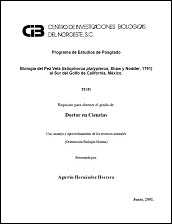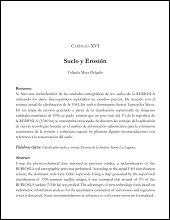Modulación de mareas someras en regimenes de tipo mixto
Resumen
Se usa un modelo numérico bidimensional, verticalmente integrado, para estudiar las interacciones no lineales de la marea en la Bahía de Yavaros, una laguna costera somera y estrecha, conectada con el Golfo de California, con régimen de mareas mixto. El nivel del mar y las corrientes obtenidas del modelo son validados al comparar los armónicos obtenidos a partir del modelo contra los obtenidos por análisis armónico de las series de tiempo de las observaciones de nivel del mar y las corrientes. Las componentes de mareas someras MK3, MS4 y M4, generadas por la advección y la continuidad no-lineal fueron las más energéticas. Se encontró un remolino con giro anticiclónico, del tamaño de media cuenca, cuya fuente de energía provino de la marea M2. El tamaño del bajo, donde ocurre el remolino, es casi el mismo que el de la máxima longitud de la excursión de la marea (~3 km). El modelo fue capaz de reproducir los aspectos no-lineales más sobresalientes de la laguna. Durante el otoño de 1999 se realizó un estudio de 56 días de duración del nivel del mar y corrientes en la misma laguna costera. Al final de la primavera de 1998, un experimento similar fue realizado en la misma laguna, aunque su duración fue menor. Las mediciones son usadas para investigar la modulación de las mareas someras. El enfoque de la demodulación compleja reveló que no sólo el ciclo de la trayectoria de la luna modificó la iv generación de mareas someras, sino también la declinación de la luna y la declinación del sol. Las mareas sexti-diurnas mostraron modulación por el ciclo de mareas vivas a mareas muertas. Las mareas quinti-diurnas estuvieron por encima del nivel del ruido sólo cerca del solsticio de verano. Las mareas cuarti-diurnas fueron moduladas por el ciclo de mareas vivas a muertas en el interior de la laguna, pero esta modulación fue alterada por la fricción en la boca de la laguna. En este sitio, la banda cuarti-diurna de la corriente de marea tuvo un máximo en amplitud durante mareas muertas. Las mareas terci-diurnas estuvieron moduladas irregularmente. La advección y el término de continuidad no-lineal estuvieron correlacionados con las bandas terci- y cuarti-diurnas de la corriente de marea. Las mareas semidiurnas fueron las que aportaron la mayor parte de la energía de la corriente residual durante el equinoccio de otoño de 1999 [...] The non-linear tidal interactions in the narrow and shallow coastal lagoon Yavaros Bay, an ecosystem with a mixed tidal regime in the Gulf of California, are investigated using a vertically integrated two-dimensional numerical model. The model sea surface elevations and currents are validated by comparison of computed tidal harmonics against those derived from harmonic analysis of the sea surface and current time series. MK3, MS4, and M4, generated by advection and non-linear continuity, are the most energetic shallow water constituents. A large, half-basin clockwise eddy was found, whose source of energy is the M2 tidal energy flux. The size of the shoal where the eddy occurs is almost the same as the maximum tidal excursion length (~3 km). The model was able to reproduce the non-linear features of the lagoon. During the autumn of 1999 a 56-day-long observational study of sea surface elevation and currents was made in the same coastal lagoon. During the late-spring of 1998 a similar experiment was as well performed at the same coastal lagoon, although shorter. The measurements are used to investigate the modulation of the shallow water tides. The complex demodulation approach revealed that not only the moon’s path cycle modified the generation of shallow water tides but also the lunar declination and the solar declination. The sixth-diurnal tides showed a spring-neap modulation. The fifth-diurnal tides were vi above of the noise level only close to the summer solstice. The fourth-diurnal tides were modulated by the spring-neap cycle at the basin, but this modulation was changed by friction at the inlet. At this site, the fourth-diurnal band of the tidal current had a maximum in amplitude during neap tides. The third-diurnal tides were irregularly modulated. The advection and the non-linear continuity terms were correlated with the third- and fourthdiurnal bands of the tidal current at the inlet. The quadratic friction terms were correlated with the sixth-, fourth-, and third-diurnal bands of the tidal current. The semidiurnal tides mainly provided the energy of the tidal residual current during the autumnal equinox of 1999 [...]
Colecciones
Ítems relacionados
Mostrando ítems relacionados por Título, autor o materia.
-
PROMOCIÓN DEL PERIFITON PARA EL CULTIVO DE CAMARÓN BLANCO: HACIA UNA ACUICULTURA ECOLÓGICA
DOMENICO VOLTOLINA LOBINA; JUAN MANUEL AUDELO NARANJO; MARIA DEL ROSARIO PACHECO MARGES -
Suelo y Erosión
YOLANDA LOURDES MAYA DELGADO


